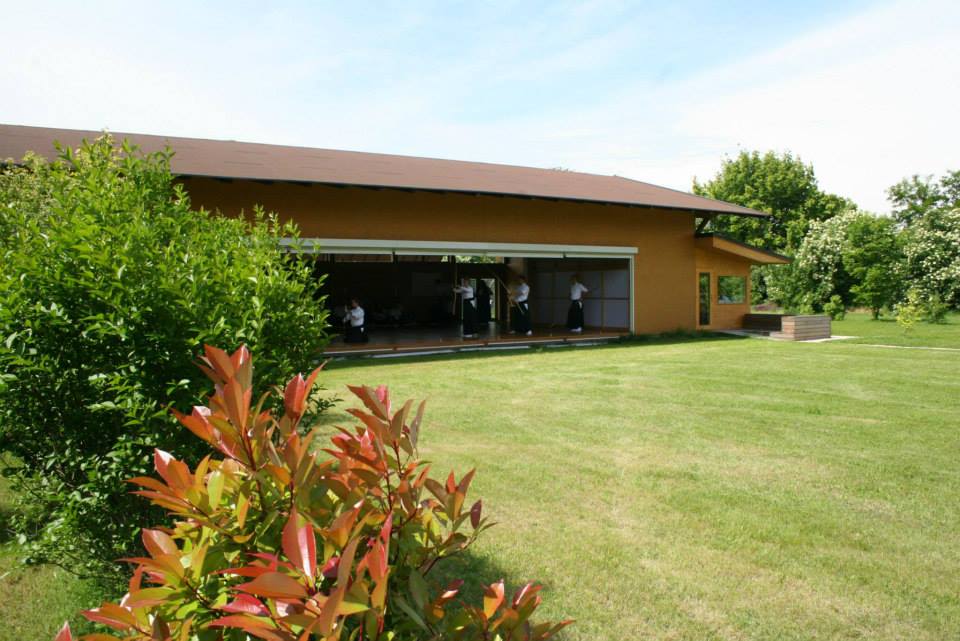|
There are currently around 60 Shogo title holders in Europe. For the last four years the EKF successfully hold European shogo seminars in various cities in Europe. The seminars were in the format of a benkyokai - workshop. The topics included shooting technique, care-taking aspects and cultural background information.
To further strengthen the bonds between the European Shogo title holders, the EKF Shidoiinkai encourages the member federations to attend another Shogo Seminar at the Alster Dojo in Hamburg in the autumn 2019.

 Terence Griffin, renshi godan, was asked to give a lecture on a topic of his choice:
Terence Griffin, renshi godan, was asked to give a lecture on a topic of his choice:
It says in the Raiki Shagi: “ Kyudo is the way of perfect virtue” - But how does that work? How does shooting a bow and arrow become a transformative practice?
As one of the forms of Budo how does Kyudo differ from training in other sports or practices? Golf and ballet, for instance, both need training, they require body and mind control but they do not claim to lead to truth, goodness and beauty.
If we don’t understand this central, important aspect of kyudo - what it is and how it works - how can we make sure to preserve it in our practice so that we can ensure that Kyudo never loses it?
The Kyudo Manual says: “The absolute Truth cannot be understood, it can be intuited but not defined. As a result we must endlessly examine our relationship to our shooting, as we are that which distorts and removes us from being in Truth.”
What is it in us that distorts our understanding of the Truth?
In every activity there is a goal and humans are somehow programmed to want to achieve it - a Hole in One, a Gold Medal, the World Cup.
In Kyudo we have the target.
But Kyudo insists that hitting the target is not the aim of Kyudo.
It says that the true aim is the other way around - we should try to achieve a single purpose - to arrive at a point where hanare arises naturally without our human drives and calculations playing any part. It says that we must strive for a movement of absolute simplicity uncomplicated by the mechanism of the egoistic mind.
The result of such a hanare, Kyudo tells us, will be an arrow in the target -
but this is not the arrow in the target that we shot before when we were simply trying to hit. This is in an arrow that comes out of The Way.
I should say here that Budo is one of the greatest gifts that Japan has given to the World. But the gift is to the human heart - to all humans of whatever race or nation. The Way of Kyudo is a universal Way. So, while we must always depend on the mastery and understanding of the Japanese Masters that have come from centuries of exploration and practice, we must also find the Way in our own European hearts and European lives.
When we first start as beginners in Kyudo our bodies are almost completely devoted to following an idea - our idea of what we think we are doing. We have seen our teacher demonstrate the movement and we think we follow exactly what we have seen - but our ideas of what our bodies are doing doesn’t conform with what our bodies are really doing.
First, we usually have only a hazy idea about what it is we are trying to do; second, the body is unused to making such movements and, third, the sensation feedback, the communication between mind and body, isn’t working very well so the body takes on a form that bears little resemblance to the image that we have of ourselves.
Modern research shows that practice changes our mind. We become what we do. The more we practice the more the neural pathways to our muscles are reinforced. Our brains change. We become more accurate in our movements. Our feedback sensations become more and more acute so our idea of what we are trying to do becomes both more focussed, and at the same time, larger and more inclusive.
But though our bodies and brains get more trained we notice that our minds are also caught up in a net of emotions of desire and fear - a desire to succeed, to hit the target; a fear of failure, of making a fool of ourselves.
So, we begin to understand that our intentions are also an important part of our training. We have to incorporate these higher aims in our everyday practice. We have to work to be more and more honest with ourselves about what is our true aim.
Our intention should be the cultivation of Truth, Goodness and Beauty.
As the Kyudo manual hints, these three principles are in fact different aspects of the same thing: ‘Beauty is the form of Truth expressed in the application of the Good.’
The manual also mentions the principles of wisdom outlined by the schools of Confucius and Mencius: wisdom, benevolence, bravery, righteousness and good manners. We can also add the ideals of the Bu side of Budo - those chivalrous aspects of the warrior ethic that remain when the horrors, brutality and cruelty of war have been stripped away - courage, comradeship, self-sacrifice, loyalty and persistence - to the list of attributes that we are trying to cultivate through our practice. All in all, this provides a comprehensive ethical basis for our lives.
The first line of the Hsinhsinming by Seng-ts’an - a great Zen classic - reads “The Way is’nt hard to find - just refrain from choosing”.
The choices we make in life are usually directed by the ego-mind to make us feel good. It is not a true choice but a choice already bent and twisted by our desires. But what is this ego mind? The ego itself does not exist - it’s just a name we give to the way in which we construct our own ideas about our identity.
We are born into the flow of the universe - the current of the eternal present.
We gradually learn the name we have been given, our ascribed gender, the behaviour our society expects from us. We find successful strategies and unsuccessful strategies. We learn to manipulate our internal drives and our external behaviour to get what we want and to avoid what we don’t want. What we want is to feel good. What we don’t want is to feel bad.
Out of all this arises our idea, our story, our construction of who we think we are. And much of our thinking and behaviour comes out of that constructed identity.
In order to identify ourselves as individuals, we separate ourselves from everything around us, we cut ourselves off from our place in the flow of the universe. We use our minds to divide dogs from cats, my dog from your dog, me from you, me from the rest of the world.
When we come to Kyudo we bring this whole, complicated lumbering ego-circus along with us. We try to find ways to get kyudo to make us feel good - we enjoy the superior feeling of knowing about things other people don’t, we get grades and titles that satisfy our sense of progress, we like it when our arrows hit the target and we get praise and applause. It all goes to feed the egoistic mind. And it all takes us further away from the true target.
Luckily for us the Way of Kyudo has the ability to break the heart of the ego-driven mind.
As it says in the testament of Master Yoshimi: “From the outside, shooting seems exceedingly simple, but shooting embraces the three spheres of mind, actions, and thoughts; and these spheres, being linked together one to the other, bring a thousand upon ten thousand changes to the inner workings of the art, making it difficult to strike the center of the mark. That which is captured in the morning is lost in the evening.”
We don’t pass an exam, we don’t hit the target, there are days when nothing goes right and our ego is diminished. Painfully diminished. In the end, however successful we may be, we begin to understand that if Kyudo is pursued to build the ego it will disappoint us. We will fail - and we will end up feeling bad.
If we look once more at the egoistic mind we can come to see that it is of course a dream, a construction of ideas. It is not who we truly are. The world flows on without stopping.
Everything, ourselves included, is in a state of constant flux and change. But we seem to need to see ourselves as permanent, unchanging entities - like rocks in the stream. We resist the idea that we are, after all, only part of the flow with no past that we do not remember and no future that we do not dream and a present that is a constant struggle to keep the idea of our false self alive.
Our bodies, moods, emotions, energy levels change from moment to moment but we prefer to think that we are always there, just like always, the one steady thing in a whirling universe.
Kyudo helps us to discover the flow of the universe and to integrate us with it. It is the flow of the present that we feel now and then when, for some reason or other, an arrow leaves the string and arrives in the target without us having done very much. It’s only when, delighted with the result, we try to repeat it, that we can see, if we are honest, that it was not our effort that made the shot succeed.
We begin to see that when we fail it is because we were trying to succeed.
When we do succeed it is only because we have, for a moment, forgotten the distorting desires of our egoistic mind.
Perhaps this is how Kyudo maps out the Way. It locks us into a scrupulous examination of the present, it gives us, as our true aim the dismantling of the false dreams of the ego it leads us towards the Truth about ourselves and our place in the world.
Kyudo gives us the opportunity to practice the intention of finding a more honest, more confident, more generous way of living, and it does all this by leading us very exactly through the Eightfold Path of the Hassetsu - always searching for what we can undo in the self-serving mind, learning how to control our competitive drive, how to find harmony with our companions, finding what we can simplify, trust, express honestly and openly - always searching for how to make one perfect gesture - even as we acknowledge that the goal is ultimately impossible to achieve because the goal is, itself, an idea that ultimately we have to discard.
The second by second awareness of breath gives our movements timing and a sense of space - of Ma. The awareness of breath is a well-known meditative technique to draw the mind away from the unbroken chattering of fear, hatred, desire and delusion - and to bring our attention more closely to the flowing present.
So we follow the Way, we reinforce our sensations of correct movement, we clarify the ideals that are motivating us, we purify our intentions and become more familiar with the flow of life.
In this way, Kyudo gives us the chance of becoming better people - not because we know what to do but because that is who we have become - that is who we are.
What a wonderful target to aim for!
Photo © Cornelia Brandl-Hoff - Link: http://www.kyudo-vienna.net
|

